Realism: Gustave Courbet |
Realism: Gustave Courbet |
| Gustave Courbet (1819-77) is usually regarded as the father of European Realism. He even used the term Realism in defining his aims and he championed the Realist cause. When his paintings were rejected for an international exhibit in Paris in 1855, he set up his own exhibit space opposite the official hall calling it the "Pavilion of Realism." His credo could be summarized in his statment: "Show me an angel, and I'll paint one"; that is, realists are only interested in the visible, the real. Typically he painted landscapes and genre paintings depicting the working class. As Gardner explains,"Plain people of the kind Courbet shows us in his work were considered by the public to be unsuitable for artistic representation and were linked in the middle-class mind with the dangerous, newly defined working class, which was finding outspoken champions in men like Marx, Engels, Proudhon, Balzac, Flaubert. Zola, and Dicken" (967). This realism was radical; this rejection of idealization was disturbing, leading critics to claim he painted "deliberate ugliness." | |
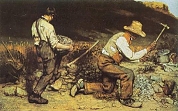 |
The Stone Breakers, 1849 (destroyed in World War II)This subject is unprecedented in the history of art; beyond that this large painting (about 8 1/2 feet wide) monumentalizes the ordinary workers, depicting them almost life-size. They are dressed in ragged clothes and down-at-the-heels sabots (shoes). Their faces are obscured, which eliminates the possibility for sentimentality and suggests the dehumanization of this type of work. These are anonymous landless peasants on a bare, monotonous road. In addition, the implication is that the young boy is destined to a life of hard toil and poverty, like that of his much older co-worker. Contrast this work with the more romantic view of peasants in Millet's The Gleaners. |
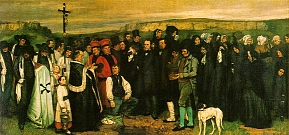 |
The Burial at Ornans,1849 This painting was shocking to Parisian audiences. It is an immense canvas (about 10 by 22 feet), the scale of a history painting--those important paintings based on historical, mythical or Biblical subject matter; yet this painting depicts the drab facts of ordinary life--the interment of a distant relative of Courbet's outside the painter's native town. Would any sophisticated Parisian among Courbet's audience be interested in a typical country funeral in a provincial town?Fifty-one figures are lined up in a row, a kind of additive, artless compositional device at odds with Academic formulas. They are from various social strata, perhaps suggesting an equal status before death. And the grave in the foreground opens up to the viewer's space. Just as Courbet rejects formulaic compositions, he also rejects idealization. Here critics were right to accuse him of "deliberate ugliness." Note, for example, the bulbous noses of the beadles. A realist would respond--aren't people ugly in the real world? Furthermore, none of the people seem to have appropriate emotions. Most seem bored. The viewer is given no clues about how to respond. |
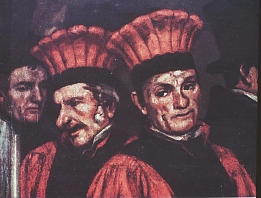 | |
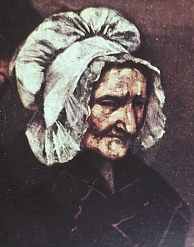 | |
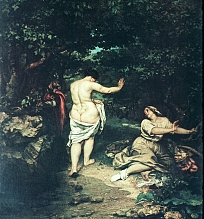 |
Women Bathing, 1853This painting was the scandal of the Salon of 1853. Viewers expected nude women to be mythological goddesses or allegorical figures. Instead, Courbet seems to depict an ordinary nude woman. He also violates the canon of proportions of the female nude--Academic nudes were slender with porcelain skin. One critic complained that Courbet had depicted a 45-year old woman at the point of washing herself for the first time in hope of relieving her varicose veins. Another called her a rhinoceros. The lesson: female nudes aren't supposed to be realistic! |
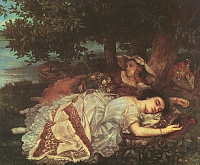 |
Young Ladies on the Bank of the Seine,1856This painting was also considered scandalous at the Salon. The title was insulting because these aren't "ladies" but working class girls of easy virtue. Sleeping women in partial undress suggest passive sexual availability--a kind of sexual abandon on the grass. These women aren't beautiful, but ugliness epitomizes Realism, one of the commonest experiences of life. In addition these womem seem unposed--the typical composition of a realist. |
All images marked MAS were photographed on location by Mary Ann Sullivan. All other images were scanned from other sources or downloaded from the World Wide Web; they are posted on this password-protected site for educational purposes, at Bluffton College only, under the "fair use" clause of U.S. copyright law.